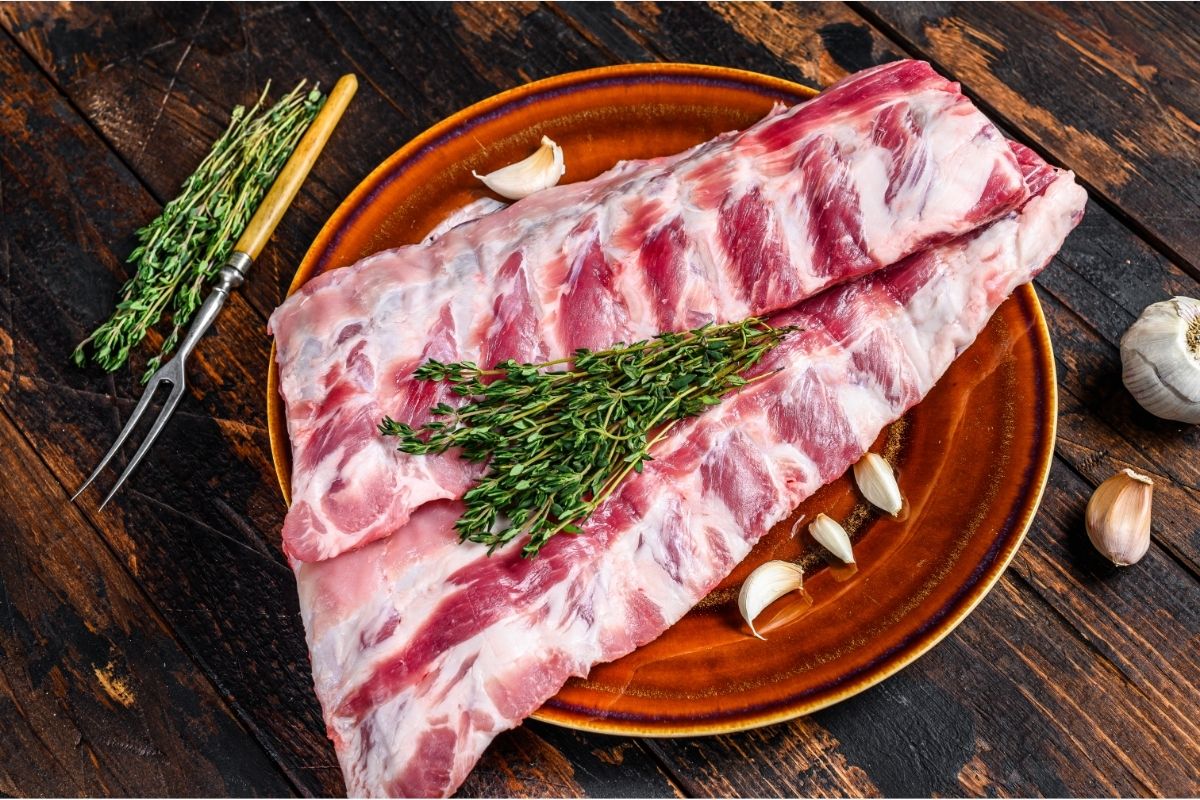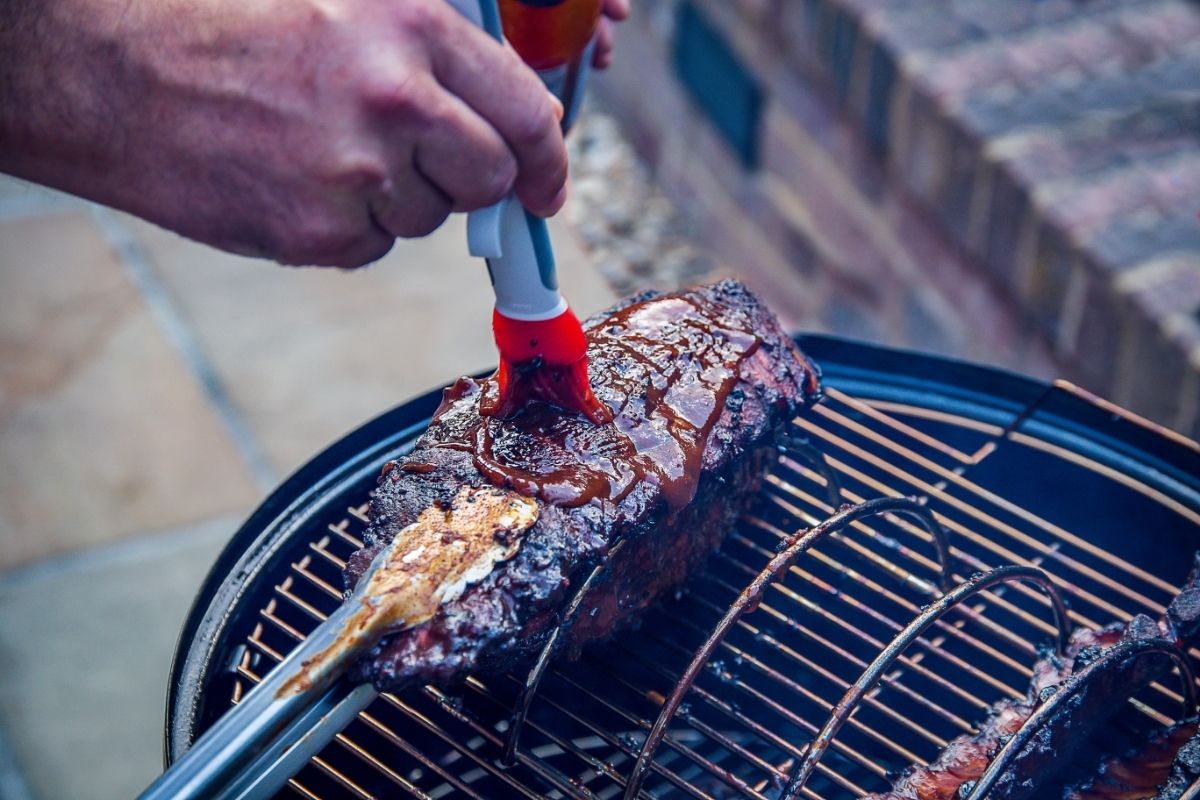No barbecue would be complete without the succulent and mouth-watering addition of ribs. And this crowd-pleaser is one of our grill favorites.

But when it comes to choosing which ribs to serve your friends and family, it can be difficult to know what exactly you’re getting.
Depending on where you purchase your meat from, whether it’s a butcher, online store, or your local grocer, meat cuts can be labeled in different ways, which means that it can make it tricky to know what’s what.
This is especially true with ribs, as the different names can confuse us all. In this guide, we’re going to take a look at pork loin back ribs and baby back ribs in particular, including what they are, if they differ in any way, and how to cook them.
Are There Any Differences Between Pork Loin Back Ribs And Baby Back Ribs?
When the warm, sunny afternoons return and you’re eagerly anticipating the day you can put your grill skills on show again, one of your tougher decisions may be deciding which meat cuts you should buy.
And as ribs are always a popular choice, trying to find the right kind of ribs can be a little challenging, especially with pork cuts. For instance, you may have a little difficulty choosing between pork loin back ribs and baby back ribs, but what’s the difference?
In all honesty, these are just two slightly different names for the same cut of meat, and there are no notable differences between pork loin ribs and baby back ribs (except for maybe discrepancies in size depending on the size of the pig itself).
But what exactly are these cuts, and where on the body are they taken from?
Pork loin back ribs come from the area where the spine connects to the ribs, which is located just above the rib cage of the pig. Once the loin cut has been taken, the pork loin ribs are usually the next cut that is made.
This particular cut of meat is rather small, as ribs are usually three to six inches in length – depending on the size of the pig. Because of the small size of the ribs, they’re more commonly referred to as “baby back ribs” – so this is where confusion can ensue.
Like the same cut of meat, both pork loin back ribs and baby back ribs have the same taste and tenderness. But it’s also this exceptional tenderness that means that the ribs have a tendency to dry out quickly whilst cooking.
Because of this, you must take the time to prep baby back ribs properly, and take care not to overcook the ribs.
Boneless Vs Bone-In Pork Loin Back Ribs
Although pork loin ribs are cut in a way that they are attached to the bones, it is possible to get boneless versions too, depending on how they are removed from the pig.
However, as pork loin back ribs are attached to the loin muscle, boneless rib options are essentially the same as a loin cut. And in this case, it’s much easier to purchase a loin cut as it is a much larger cut of meat.
A lot of people prefer to eat bone-in pork loin back ribs, otherwise, most opt for loin meat instead.
What’s The Difference Between Pork Loin Back Ribs And Spare Ribs?
So now we’ve established that there are no actual differences between pork loin back ribs and baby back ribs, let’s take a look at how they differ from spare ribs.
Both cuts come from pigs, which means that they are both classified as pork. However, the most notable differences between the two cuts are which part of the body they are cut from, their size, and their tenderness (or lack thereof).
As baby back ribs are cut from where the rib meets the spine (once the loin has been removed), they have a distinctive curved shape. Spare ribs, on the other hand, are cut from the belly of the pig and are much meatier and fattier in comparison.
Spare ribs are also flatter and more rectangular, which makes them much easier to sear, and also explains why they are the preferred cut of some chefs and certain recipes. But how do the two differ in taste?
As a result of the high-fat content of spare ribs, they are not as lean or tender as baby back ribs, which is most likely the reason why baby ribs are the far more popular choice.
With the increased popularity, however, comes a higher price tag, and as baby back ribs are considerably smaller in size, you will need to spend much more on ribs when catering to larger crowds.
Despite the preference for baby back ribs, spare ribs are often considered to be more flavorful when cooked properly, because of their higher fat content.
It’s also worth mentioning that if you ever come across St. Louis ribs, these are spare ribs that have been trimmed in a specific way.
For this particular cut, the breastbone and cartilage are cut away to create a more rectangular shape. Although St. Louis ribs have a neater appearance, the texture and flavor of the meat are the same as regular spare rib cuts.
How Many Baby Back Racks Should I Buy Per Person?
When it comes to getting the right number of ribs for your guests, numerous factors will affect your choice.
For instance, the age and appetite of your guests, the time of your event, and the other cuts of meat and sides that you will be serving will all contribute to the number of racks you should buy.
The general rule of thumb, however, is that five or six ribs per person should be enough. Depending on the size and breed of a pig, they will have either fifteen or sixteen ribs, and some of these are located on the left shoulder where the loin meets the shoulder blade.
As a result, some racks will have more ribs than others, but a rack needs to have at least eight ribs for it to be sold in stores and on meat counters. Generally, a rack of baby back ribs will have ten to thirteen ribs and has an average weight of around 2 lbs.
Based on these averages, one rack of ribs should be enough to feed two people, so it’s worth using this as a guideline when planning how much you will need to purchase.
It’s also worth bearing in mind that some baby back ribs don’t have much meat on them, and have a lighter weight. Although the meat is still tender, you need to be careful when cooking lightweight racks as the chance of overcooking them is far greater.
How To Cook Baby Back Ribs
Although the meat on baby back ribs is tender and flavorsome on its own, it’s always best to season your meat to enhance the flavor. It’s also extremely popular to make a delicious sauce to accompany your ribs, and most people opt for a rich and smoky BBQ sauce.
When it comes to seasoning, salt and pepper are the obvious choices. However, you can take your ribs to the next level by using dried herbs, cayenne pepper, smoked paprika, or ground mustard.
We also recommend using brown sugar for a rich, sweet taste, but if you use sugar keep in mind that it’ll burn easily when exposed to high temperatures.
When cooking ribs, you’ll get the best results when choosing a low and slow cooking method like smoking.
This long cooking process breaks down the connective tissues and gives the fat time to render, which will make the meat so tender that it will easily pull away from the bone in the best way possible.
If you’re going to add sauce to your ribs you mustn’t brush it on too early. It’s always best to wait until the final few minutes, as this will give the ribs a nice glaze without ruining the texture or taste.
As mentioned, BBQ sauce is the most popular option for baby back ribs, but as it has a high sugar content it can easily burn when left on high heat for too long. This will result in a bitter flavor, which will ruin your hard work.
Smoking Baby Back Ribs
Smoking your ribs will give them a rich flavor that is sure to impress your guests. However, it can take a few attempts to learn how to smoke meat properly, so you must follow instructions properly.
When setting up your smoker, make sure you follow the manufacturer’s guide.
Preheat your smoker to a temperature of 225°F, and place your ribs inside the bone side down for around four to five hours, depending on the size of your ribs.
Brush your ribs with a glaze after one hour, and continue to do so every hour of cooking to keep your ribs nice and moist.

Use a meat thermometer to check the temperature of your ribs, as they should have an internal temperature of 145°F once they are cooked and ready to serve.
Although smoking is arguably the best way to prepare your ribs, it is also one of the most expensive, so it’s worth bearing that in mind, especially if you don’t host barbecues or cook for large crowds often.
Can You Substitute Baby Back Ribs For Spare Ribs?
This is a very prominent debate amongst grilling fanatics and one we’re going to help you get to the bottom of.
If you’re having trouble finding pork loin back or baby back ribs, you can easily swap them out for spare ribs instead. However, as the cuts vary, there are a few adjustments that you’ll need to make.
The first major difference is that spare ribs have much more meat, which means that you won’t need to use as many. If a recipe uses baby back ribs as one of the ingredients but you plan on using spare ribs, cut down the rib quantity by about a third.
In addition, the higher meat and fat content means that spare ribs need a much longer cooking time. Whereas baby back ribs can take as little as an hour to cook, spare ribs can easily take twice as much time.
As spare ribs have a higher fat content, the risk of overcooking them is also significantly less.
You should also use greater quantities of seasoning if you intend to use spare ribs as a substitute, as you’ll have to account for the increase in size.
Final Thoughts
Despite the different labels, there are no actual differences between pork loin ribs and baby back ribs, so rest assured that these cuts are the same.
However, learning different names for meat cuts can mean that you’ll have far more success choosing your desired cut each time you visit the butcher or meat counter. In addition, you’ll also impress your local butchers and fellow grill enthusiasts with your knowledge!
Just remember to season accordingly, and cook your ribs using a “low and slow” method for the most tender and flavorsome ribs around.
- The 9 Best BBQ Grills for Smoking Brisket - December 29, 2022
- 6 Mouth Watering Grilled Shrimp Recipes - September 16, 2022
- 6 Delicious Grilled Desserts - September 16, 2022

